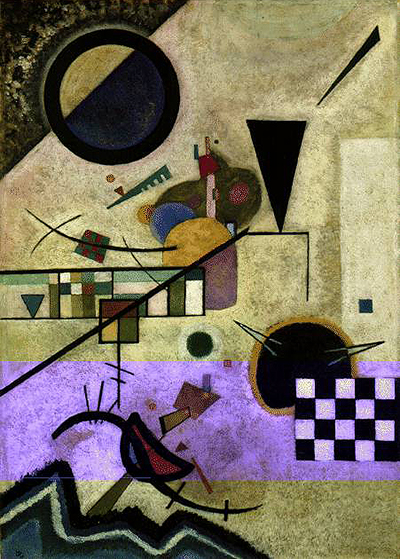The visualisation of sound was an important theme in the work of Kandinsky and Klee. Contrasting Sounds offers an example of the former’s interest in this.
Squares and circles create this composition, which is not quite as chaotic as some of his other pieces. There is interest right across the left hand side of the painting, as well as a chequered black and white block on the right. The majority of this scene is a combination of beige and black, though a dominant purple stripe is found near the foot of the painting. Other colours are included in the smaller shapes found in the centre of the painting. Larger shapes includes a triangle and two circles which are dark and placed on the fringes of this scene. Once we have taken in the abstract shapes and swirls, the obvious thought is, just what do they mean? This is typical of abstract art in general and Kandinsky in particular.
Kandinsky was heavily involved in the theories behind art. He studied existing publications in detail and then produced several written scripts of his own. He achieved an impressive understanding of colour and started to experiment with how it impacted abstract art, where form was not as immediately obvious. To add sound into this exploration would give another sphere of interest to this deeply thought individual. He represented the new age, where traditional art, including the theory and history behind it, would now be set aside to allow for a new school of thinking to take over. He understood this would bring him critics and barriers of progression, but he carried on regardless.
Those studying this artist's career will find a whole plethora of artworks which follow a fairly similar pattern of arranging lines and forms across the canvas in seemingly random positions. This was a relatively novel approach at the time, and had to take on challenges to its integrity before finally achieving acceptance. He was experimenting as he went, practicing these arrangements in drawn sketches before putting them together in one composition after another. This abstract work feels modern even today, though there still remains plenty of appreciation of the more traditional styles of art. There is now the freedom of expression and also a wealth of information around that allows us to enjoy a wide variety of art without fear of criticism.




